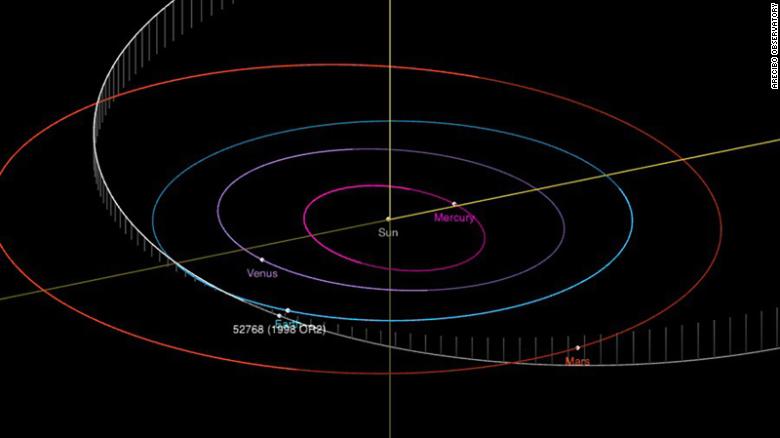- Click to share on Facebook (Opens in a new window)
- Click to share on Twitter (Opens in a new window)
- Click to share on LinkedIn (Opens in a new window)
- Click to email a friend (Opens in a new window)
Asteroid "protected against covid-19", will pass close to Earth on April 29 0:38
(CNN) - An asteroid approximately 2 km wide will fly close to Earth early Wednesday morning, but it is not expected to collide with our planet.
The asteroid is called 52768 (1998 OR2), and was first seen in 1998. On April 29, it will pass 6.28 million km from Earth, moving at 31,320 km per hour. That is still 16 times farther than the distance from Earth to the Moon.
The flyby is expected to occur on Wednesday, April 29 at 5:56 am ET, according to NASA's Center for Near-Earth Object Studies. The center tracks near-Earth objects (or NEOs) that could collide with Earth. They have been tracking this particular asteroid for 20 years, according to NASA.
READ : These astronauts have just returned to Earth to find a world transformed by the coronavirus
You can see it live on the website of The Virtual Telescope. Gianluca Masi, founder and scientific director of The Virtual Telescope in Italy, has been tracking and imagining it for some time.
If it did indeed impact Earth, the asteroid is "large enough to cause global effects," according to NASA, when the asteroid was discovered.
And if an asteroid could be aware of these things, it appears to be wearing a face mask in deference to the pandemic, according to new images from the Arecibo Observatory in Puerto Rico.
"Small-scale topographic features like hills and ridges at one end of the 1998 OR2 asteroid are scientifically fascinating," said Anne Virkki, head of planetary radar at the Arecibo Observatory, in a statement. "But since we're all thinking of covid-19, these features make it look like OR2 1998 was wearing a mask."
READ : Astronomers find "foreign" asteroids that live in our solar system
The Arecibo Observatory is a National Science Foundation facility managed by the University of Central Florida. A team of experts has been monitoring this near-Earth asteroid, among others. The observatory is supported by NASA's Near-Earth Object Observation Program and has been analyzing asteroids since the mid-1990s.
During the pandemic, Arecibo scientists continue to make their observations on behalf of planetary defense. In line with social distancing, they have limited the number of scientists and radar operators at the facility, and wear face masks during observations.
Anne Virkki, head of the Arecibo Observatory planetary radar, wears her face mask in front of a radar image of the 1998 asteroid OR2.
The asteroid was classified as a potentially dangerous object because it measures more than 152 meters and is 8 million km from Earth's orbit. Arecibo experts can monitor asteroids and use observations to determine their future path to see if they pose a risk to Earth.
"Radar measurements allow us to know more precisely where the asteroid will be in the future, including its future approaches to Earth," Flaviane Venditti, a research scientist at the observatory, said in a statement. "In 2079, the 1998 asteroid OR2 will pass Earth about 3.5 times closer than this year, so it is important to know its orbit accurately."
READ : UFOs: This is what we know about the videos of the Pentagon, Area 51 and more
The white line shows the route of 1998 OR2.
It is the largest asteroid expected to fly close to Earth in the next two months, but it is not the largest in history.
That honor belongs to asteroid 3122 Florence (1981 ET3), which flew past and luckily did not collide with Earth on September 1, 2017. It will pass again on September 2, 2057. That asteroid is estimated to be between 3 to 9 kilometers Wide.
Asteroid

